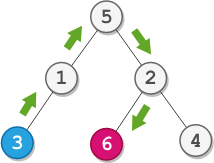Description
ou are given the root of a binary tree with n nodes. Each node is uniquely assigned a value from 1 to n. You are also given an integer startValue representing the value of the start node s, and a different integer destValue representing the value of the destination node t.
Find the shortest path starting from node s and ending at node t. Generate step-by-step directions of such path as a string consisting of only the uppercase letters 'L', 'R', and 'U'. Each letter indicates a specific direction:
'L'means to go from a node to its left child node.'R'means to go from a node to its right child node.'U'means to go from a node to its parent node.
Return the step-by-step directions of the shortest path from node s to node t.
Example 1:

Input: root = [5,1,2,3,null,6,4], startValue = 3, destValue = 6 Output: “UURL” Explanation: The shortest path is: 3 → 1 → 5 → 2 → 6.
Example 2:

Input: root = [2,1], startValue = 2, destValue = 1 Output: “L” Explanation: The shortest path is: 2 → 1.
Constraints:
- The number of nodes in the tree is
n. 2 <= n <= 1051 <= Node.val <= n- All the values in the tree are unique.
1 <= startValue, destValue <= nstartValue != destValue
Code
Lowest Common Ancestor of a Binary Tree 的延伸,加上 dfs + backtracking
Time Complexity: , Space Complexity:
/**
* Definition for a binary tree node.
* struct TreeNode {
* int val;
* TreeNode *left;
* TreeNode *right;
* TreeNode() : val(0), left(nullptr), right(nullptr) {}
* TreeNode(int x) : val(x), left(nullptr), right(nullptr) {}
* TreeNode(int x, TreeNode *left, TreeNode *right) : val(x), left(left), right(right) {}
* };
*/
class Solution {
public:
string getDirections(TreeNode* root, int startValue, int destValue) {
auto lca = LCA(root, startValue, destValue);
string toStart = "", toEnd = "";
getDir(lca, toStart, startValue, true);
getDir(lca, toEnd, destValue, false);
return toStart + toEnd;
}
TreeNode* LCA(TreeNode* root, int startValue, int destValue) {
if(!root || root->val == startValue || root->val == destValue)
return root;
auto LCA_l = LCA(root->left, startValue, destValue);
auto LCA_r = LCA(root->right, startValue, destValue);
if(LCA_l && LCA_r)
return root;
return LCA_l ? LCA_l : LCA_r;
}
bool getDir(TreeNode* root, string& path, int value, bool findStart) {
if(!root)
return false;
if(root->val == value)
return true;
path += findStart ? 'U' : 'L';
if(getDir(root->left, path, value, findStart))
return true;
path.pop_back();
path += findStart ? 'U' : 'R';
if(getDir(root->right, path, value, findStart))
return true;
path.pop_back();
return false;
}
};